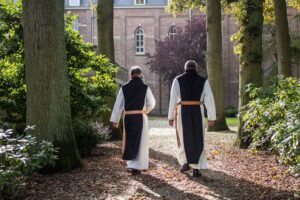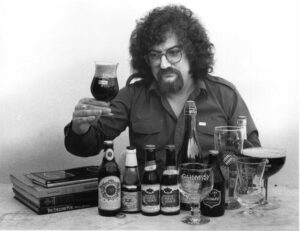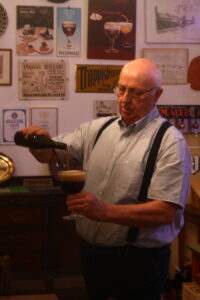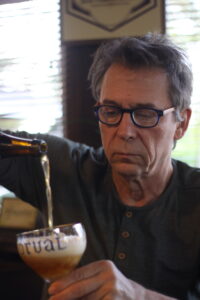

To be clear: Trappist is not a beer style. In the original sense, it is beer brewed by monks of six Belgian Cistercian abbeys, neatly distributed across Flanders and Wallonia: Westvleteren, Westmalle and Achel in the Dutch-speaking part of the country and Orval, Chimay and Rochefort in the French-speaking part.
In the meantime, there are also Trappist beers of Dutch, French, British, Austrian, Italian and American origin on the market.
In this series, we look for what all these beers have in common, even though they are very different in terms of beer styles: bockbeer, double, triple, quadruple, barleywine, IPA, witbier, Weizen, imperial stout, and so on.
First some history. The seeds of the Trappist order were sown by Benedict of Nursia, who according to historians founded the Italian abbey Monte Cassino in 529. His precept was: 'Ora et labora'. To this day, the lives of the monks who follow the Rule of Benedict consist of prayer and work.
As far as we know, the first fathers' beer was brewed in the blessed year 820 by monks from the Benedictine abbey in Sankt-Gallen, Switzerland. Soon beer began to be brewed in other monasteries as well to quench thirst.
Beer brewing in abbeys was permitted by the Rule of Benedict, which stipulated that the local drink could be made in the monastery to offer to travellers and pilgrims. In the south, this was wine, in our regions beer.
Moreover, beer was a perfectly reliable drink in times of plague and other epidemics. Beer is a boiled drink, therefore free of germs. Whereas contaminated drinking water was warp and weft. Finally, in those days beer had a low alcohol percentage, comparable to today's table beer, and was even consumed by toddlers.
Enter the Trappists. In 1098, abbot Robert, a Burgundian nobleman, left his monastery in Molesmes to found a new monastery with twelve monks in Citeaux, Burgundy. According to the abbot, Benedict's Rule was being observed less and less in the French Benedictine monasteries. He named his new order after Cistercium, the Latin name of Citeaux.
The so-called Strict Observance in the Order of Cistercians would later also become known as the Trappist Order. The most important characteristic of this order was the abstinence from meat, which explains why the monks of this order were called 'abstainers'. Apart from abstinence from meat, manual labour was an essential part of their existence.
Armand Jean de Rancé, abbot of the Normandy abbey of Notre Dame de la Grande Trappe, went even further in 1664: the monks had to maintain a continuous silence. The Trappists owe their name to this abbey. It was not until 1892 that Pope Leo XIII recognised the Order of the Strict Observance. From then on, the Trappist order was an independent order.

Initially, Dom De Rancé only allowed pure water to be drunk. But when it turned out that the water was often undrinkable, the monks of Notre Dame de la Grande Trappe were also allowed to drink regional drinks such as cider and beer.
At the end of the 18th century, during the French Revolution, a group of monks fled the abbey of Notre Dame de La Grande Trappe. They wanted to found a monastery in Canada, but as there was no ship that could take them there, they eventually settled in Westmalle.
In 1794, the French refugees were allocated a small farm by the Bishop of Antwerp. Initially, the monks made butter which they sold at the gate. When the monastery was transformed into a fully-fledged Trappist abbey in 1836, the monks also started brewing beer. The dark, sweet table beer was only for their own use. The world's first Trappist beer was born.
Twenty years later, two types of beer were brewed: white table beer and a stronger brown beer. The forerunner of Westmalle Dubbel was sold by the jug or the barrel as an additional source of income, alongside agriculture, cattle breeding and wine growing (which ended shortly before the First World War).
In 1932, the prior of Westmalle and, a year later, the non-profit organisation Westmalle registered the Trappist beer brand. Up until the 1960s, many breweries misused this designation of origin. Amongst others, Cardinal Trappist (Het Anker), Trappist 't Kapittel (Van Eecke), Trappist Stavelot (Moortgat), Trappist van Veltem (Anglo-Belge) and Trappist BMS (Brasserie de Silly) were on the market for a time.
A number of court cases put an end to this. From now on, the designation 'Trappist' could only be used for beer and other products originating from a Trappist abbey.

However, this does not mean that Trappist beer is a separate type of beer or a defined beer style. According to Jef Van den Steen, probably the world's greatest Trappist connoisseur, Trappist beer fits into the Belgian beer culture of heavy, high fermentation beers.
In addition, Trappists represent a wide range and the differences between them in aroma, colour, taste and alcohol percentage are too great to speak of just one type. The designation 'Trappist beer' refers to the origin, in a sense like AOC in France and DOCG in Italy. So says Van den Steen in his 2015 standard work 'Trappist'.
After the Second World War, the monks of Chimay reached a turning point. They had to rebuild their brewery, which had been destroyed by the German troops, from scratch, and in doing so, they wanted to reconcile tradition and progress, Van den Steen knows. The direction that was chosen under the leadership of Père Theodore and with the help of Professor Jean De Clerck, was later also endorsed by the other abbeys and can therefore be regarded as the 'uniqueness' of Trappist beers.
Van den Steen claims that the secret of Chimay lies in the yeast. Someone with a good nose recognises all beers brewed in Chimay by the aromas produced by the yeast. It contains a chemical substance in which you can recognise a hint of lightly smoked meat, more specifically farmhouse ham near the leg.
To find the key to this particular yeast, we have to go back to 1946. Père Théodore, who studied brewing sciences with Professor Jean De Clerck at the Catholic University of Leuven, isolated the suitable yeast strain with the latter's help and, in his own words, "with Benedictine patience", to set to work in Chimay. As a mark of honour, Professor De Clerck was the only layman to be buried in the abbeyafter his death in 1978.
"Chimay shares with all the other Trappists the constant taste and quality," says Van den Steen. It is not because they are successful that abbeys change the way they work. Unlike expansive breweries, which sell more and more beer worldwide, they will not change their brewing techniques in order to make their beer faster.

For Trappist breweries, quality is more important than quantity. That was the case in the past and it is no different today. Most commercial beers drift along with fashion. When sweet beers became popular, lager became sweeter too. The Trappist abbeys have never gone along with this. Every Trappist beer is a rock in this respect. Blue Chimay has been around since 1954 and hasn't changed since then. What brewer can say that?
Wim Swinnen
Wim Swinnen
We are happy to share our adventure in the Trappist world. Stay tuned for our exclusive anecdotes, facts and novelties.


